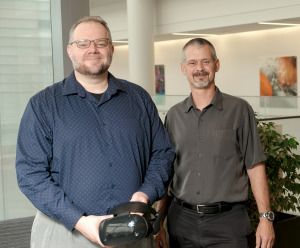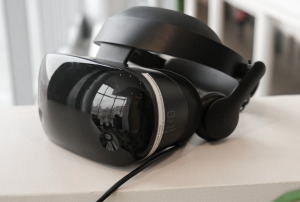Subscriber Benefit
As a subscriber you can listen to articles at work, in the car, or while you work out. Subscribe Now
An Indiana University School of Medicine team is developing a virtual-reality-based treatment that tackles a tough challenge: helping people stay sober.
The high-tech approach allows a patient recovering from substance abuse to interact with potential future versions of himself or herself. It’s meant to help patients gain a clearer vision of their future and avoid relapsing—steps that can be especially challenging for those who have recently entered recovery.
“Virtual reality allows you to do the impossible: time travel,” said Brandon Oberlin, the project’s lead researcher and an assistant professor of psychiatry at IU’s medical school.
The project, which has been in development for four years, has recently gained traction. Over the past five months, it has attracted more than $4.9 million in National Institutes of Health funding.
In September, the team published the results of its first study, and results indicated the concept is promising enough to continue development.

Oberlin and another member of the research team, Andrew Nelson, have also formed a startup, Relate XR LLC, to lay the groundwork for commercialization opportunities. IU is helping the two pursue commercialization.
Nelson, who is an IU alum and founder of Indianapolis-based Half Full Nelson LLC, has a background in virtual reality development. Half Full Nelson specializes in creating educational games and virtual reality experiences.
In the world of research grants, $4.9 million is not a huge number, acknowledged Lakshmi Sastry-Dent, director of technology commercialization at the IU Innovation and Commercialization Office. But the grant does indicate that the team has an idea worth pursuing, she said. “I think it’s a very respectable start for a technology at this stage of advancement.”

How it works
The research team is developing a tool that takes photos, informational interviews and voice samples of a patient and uses the information to create two separate avatars. One represents a future in which the patient has remained sober for 15 years. The other—a more disheveled, fidgety and visibly aged future self—represents what the patient might be like after 15 years of continued substance abuse.
During a session, the patient can talk with each avatar about what its sober—or substance-abusing—life is like, with details that are relevant to that patient’s life. The sober avatar, for instance, might talk about having earned a college degree or reunited with family members. The substance-abusing avatar might express regrets about missed opportunities or time spent behind bars.
“We are making this vivid and focused,” Oberlin said.
It’s too early to draw firm conclusions about the treatment’s potential effectiveness—but early results are encouraging, he said.
The study involved 21 people currently in treatment for substance abuse in Indianapolis. Following the virtual reality session, subjects received daily text messages with an image of their future sober avatar. Of those 21 participants, 85% maintained abstinence over a 30-day period, based on both self-reporting and results of substance-abuse testing.
“That is a pretty good rate,” Oberlin said, particularly for people in the early stages of recovery. All the subjects had been in recovery less than a year.
Relapse rates vary depending on how long a person has been in recovery and what type of substances they abused, he said, but in general, about 50% of patients in recovery experience a relapse within six months. “In that early recovery window, relapse rates are really high.”
The intent, Oberlin said, is that clinicians could use the tool as part of a larger treatment program—not as a stand-alone solution. “We don’t have any illusion that this thing is going to be powerful on its own, necessarily.”
Oberlin and Nelson say they anticipate continuing research and development for the next few years and consider it premature to say when the product might be ready for commercialization.
Nelson said the team is remaining flexible about the final product, especially as virtual reality technology continues to improve.
“It’s exciting to see where it’s all going,” he said.
One technical aspect the team is working on is the amount of time and effort required to create each avatar.
When the project launched, Nelson said, it took four or five days to craft a personalized avatar. The team has pared that down to about a day and hopes to reduce that window even further.
Initially, Nelson said, it’s likely that clinicians will collect the personal information from patients, then provide it to Relate XR, which will craft the avatar. Over time, the goal is to make the process easy enough that the avatar creation can be done at the clinician’s office.
“Eventually, the ultimate goal is that we don’t need to be in the loop as much,” he said.
Commercial potential
Even though commercialization might be years away, IU is helping Oberlin and Nelson secure patent protection for their technology and connect them with entrepreneurial resources.
Sastry-Dent said her office already has connected Oberlin and Nelson with a venture investor who might be interested down the road.
IU’s Innovation and Commercialization Office, which helps IU researchers commercialize their innovations, reviews 160 to 180 projects each year. It selects about 60% in which it sees commercialization potential.
Sastry-Dent said the project caught her eye because it could help solve a big societal problem. “I think there’s a huge need at this time for innovations in the recovery space.”
Aside from 12-step programs like Alcoholics Anonymous, Sastry-Dent said, “patients really have very few things that support them at this critical time. … There’s a huge void in this space—and [early recovery] is a dangerous time.”
A local professional with expertise in the substance-abuse field also said she sees great promise in the IU team’s project.

“I clinically love it,” said Stephanie Anderson, vice president of strategic initiatives and quality improvement at Mental Health America of Indiana. Anderson is a licensed clinical social worker and has worked in both public-sector and private-sector jobs in the field of substance abuse.
Anderson said the only other virtual reality project she’s aware of in the field of addictions is at Johns Hopkins University in Maryland. That project involves using the technology to help patients in recovery deal with stress and anxiety.
The IU project appears to build on some age-old aspects of recovery programs, she said. Substance abuse reduces a person’s capacity for abstract thought and impulse control, she said, and 12-step programs are typically structured to help people deal with these challenges.
As an example, Anderson said, a new member of Alcoholics Anonymous is asked to write a letter to his or her addicted self. That letter can take different forms, she said, but it is typically intended as a tool people can turn to if they are tempted to relapse. The letter, for instance, might talk about the person’s negative experiences as a result of addiction.
The IU project “takes that idea to a different level,” Anderson said. “… It kind of hits all of those areas and really helps an individual who needs a concrete focus.”
Oberlin said he believes his team’s project could eventually be used by patients struggling with challenges other than substance abuse.
“There’s some other areas in the mental health space that are crying out for new solutions.”•
Please enable JavaScript to view this content.

